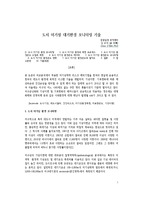

-
미리보기
목차
1. 도시 미기상 환경 모니터링
2. 도시 미기상 환경과 측정 프로세스
3. 도시 미기상 환 경온도 수집과 측정
4. 도시 미기상 환경온도 데이터
5. 도시 미기상 환경온도 모니터링
6. 도시 미기상 환경온도 영향
7. 도시 미기상 환경온도와 열지도
8. 결론본문내용
요론
본 논문의 비교분석에서 적용한 미기상학적 리스크 해석기법을 한국의 현실에 응용하고 한국의 대도시 환경에 최적인 시스템 기술을 계발하여, 기상이변・기후변화에 따른 재산파손과 건강손상을 방지할 수 있게 해야 하는 잠재적 요구가 크다고 할 수 있다. 한국 서울에는 지구의 어느 나라에도 없는 수만 명의 촛불시위가 가끔씩 벌어지고 있다.지구온난화와 기상이변 및 기후변화의 메커니즘이 상승적으로 작용하는 경우에는
대형화재와 인명피해 등과 같은 사회환경적 대형 재난이 발생될 risk가 크다고 할 수 있다.
1. 도시 미기상 환경 모니터링
지구적으로 특히 대도시 지역에서 빈발하는 아주 더운 날씨는 과다한 질병율 및 사망률과 유의성 있는 연관성을 갖고 있다. 이와 같은 기상이변은 지역에 따라 다르긴 하지만, 통상적인 최대기온 이상과 최저기온 이하로 며칠씩 계속되는 현상으로 정의하고 있다. 그 역사적 사례를 들어보자면, 1995년 미국 시카고에서 열파(heat wave)로 인해 700명 이상이 사망한 이변이고, 2003년 유럽에서 열파로 인해 30,000명 이상이 사망한 이변이고, 2010년 러시아에서 열파로 인해 15,000명이 사망한 이변이다. 2009년 캐나다의 밴쿠버에서는 110명이 초과 사망하는 소규모의 열파도 있었지만, 그래도 그 전해의 여름철에 비하여 40%나 증가한 사망률이었다.
지구상의 기상이변에 대한 대부분의 질병역학적(epidemiological) 분석에서는 특정의 지역적・환경적 기상온도 및 대기온도 측정치를 이용하고 있다. 이와 같은 기상 데이터의 질이 높긴 하지만, 도시인구에 의해 조성되는 대기온도의 변이성을 충분히 대변해 주지는 못하고 있다. 일반적인 대기기온은 100~3,000m의 미기상학적 범위에서 측정되거나, 3,000~100,000m의 지구대기권의 mesoscale(중간영역)에서 측정되기 때문이다.참고자료
· Sara B. Handerson, et al., “Microscale mobile monitoring of urban air temperature”,
· Urban Climate, 18, 2016, pp.58~72
· Barriopedro, D., et al., “The hot summer of 2010: redrawing the temperature record
· map of Europe”, Science, 332(6026), 2011, pp.220~224.
· Kosatsky, T., Henderson, S.B., Pollock, S.L., “Shifts in mortality during a hot weather
· event in Vancouver, British Columbia: rapid assessment with case-only analysis”, Am. J.
· Public Health, 102(12), 2012, pp.2367~2371.
· Shaposhnikov, D., et al., “Mortality related to air pollution with the Moscow heat
· wave and wildfire of 2010”, Epidemiol. Camb. Mass., 25(3), 2014, pp.359~364.
· Cassano, J.J., “Weather bike: a bicycle-based weather station for observing local
· temperature variations”, Bull. Am. Meteorol. Soc., 95(2), 2013, pp.205~209.
· Rinner, C., Hussain, M., “Toronto's urban Heat Island—exploring the relationship
· between land use and surface temperature”, Remote Sens., 3(6), 2012, pp.1251~1265.
· Ho. H.C., et al., “A comparison of urban heat islandsmapped using skin temperature,
· air temperature, and apparent temperature for the greater Vancouver area”, Sci. Total
· Environ., 544, 2016, pp.929~938.
· Richards, K., “Urban and rural dewfall, surface moisture, and associated canopy-level
· air temperature and humidity measurements for Vancouver, Canada”, Bound. L. Meteorol.,
· 114(1), 2005, pp.143~163.
· Gislason, P.O., Benediktsson, J.A., Sveinsson, J.R., “Random forests for land cover
· classification”, Pattern Recogn. Lett., 27(4), 2006, pp.294~300.
· Harlan, S.L., et al., “Neighborhood microclimates and vulnerability to heat stress”,
· Soc. Sci. Med., 63(11), 2011, pp.2847~2863.
· Saaroni, H., Ziv, B., “Estimating the urban Heat Island contribution to urban and
· rural air temperature differences over complex terrain: application to an Arid City”, J.
· 94
· Appl. Meteorol. Climatol., 49(10), 2010, pp.2159~2166.
· Emmanuel, R., Krüger, E., “Urban heat island and its impact on climate change
· resilience in a shrinking city: the case of Glasgow, UK.”, Build. Environ., 53, 2012,
· pp.137~149.
· Kaiser, R., et al., “The effect of the 1995 heat wave in Chicago on allcause and
· cause-specific mortality”, Am. J. Public Health, 97(Suppl.1), 2017, p.S158~S162.
· García-Herrera, et al., “A review of the European summer heat wave of 2003”,
· Environ. Sci. Technol., 40(4), 2010, pp.267~306.
· Henderson, S.B., Kosatsky, T., “A data-driven approach to setting trigger temperatures
· for heat health emergencies”, Can. J. Public Health, 103(3), 2012, pp.227~230.
· Mostovoy, G.V., et al., “Statistical estimation of daily maximum and minimum air
· temperatures from MODIS LST data over the state of Mississippi”, GIScience Remote
· Sens., 43(1), 2006, pp.78~110.
· Gallo, K., et al., “Evaluation of the relationship between air and land surface
· temperature under clear-and cloudy-sky conditions”, J. Appl. Meteorol. Climatol., 50 (3),
· 2010, pp.767~775.
· Benali, A., et al., “Estimating air surface temperature in Portugal using MODIS LST
· data”, Remote Sens. Environ., 124, 2012, pp.108~121.
· O'Neill, M.S., “What weather variables are important in predicting heat-related
· mortality? A new application of statistical learning methods”, Environ Res., 132, 2014,
· pp.350~359.
· Nichol, J.E., To, P.H., “Temporal characteristics of thermal satellite images for urban
· heat stress and heat island mapping”, J. Photogramm. Remote Sens., 74, 2012,
· pp.153~162.태그
-
자료후기
Ai 리뷰지식판매자의 자료는 제가 필요로 하는 지식을 완벽하게 충족시켜주었습니다. 과제 제출일이 얼마 남지 않아 시간이 부족했는데, 이 자료 덕분에 과제를 제출 할 수 있었습니다. 정말 감사합니다! -
자주묻는질문의 답변을 확인해 주세요

꼭 알아주세요
-
자료의 정보 및 내용의 진실성에 대하여 해피캠퍼스는 보증하지 않으며, 해당 정보 및 게시물 저작권과 기타 법적 책임은 자료 등록자에게 있습니다.
자료 및 게시물 내용의 불법적 이용, 무단 전재∙배포는 금지되어 있습니다.
저작권침해, 명예훼손 등 분쟁 요소 발견 시 고객센터의 저작권침해 신고센터를 이용해 주시기 바랍니다. -
해피캠퍼스는 구매자와 판매자 모두가 만족하는 서비스가 되도록 노력하고 있으며, 아래의 4가지 자료환불 조건을 꼭 확인해주시기 바랍니다.
파일오류 중복자료 저작권 없음 설명과 실제 내용 불일치 파일의 다운로드가 제대로 되지 않거나 파일형식에 맞는 프로그램으로 정상 작동하지 않는 경우 다른 자료와 70% 이상 내용이 일치하는 경우 (중복임을 확인할 수 있는 근거 필요함) 인터넷의 다른 사이트, 연구기관, 학교, 서적 등의 자료를 도용한 경우 자료의 설명과 실제 자료의 내용이 일치하지 않는 경우
문서 초안을 생성해주는 EasyAI

